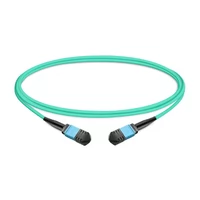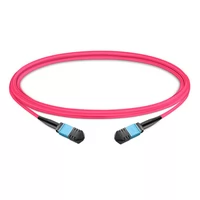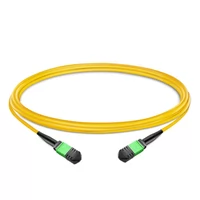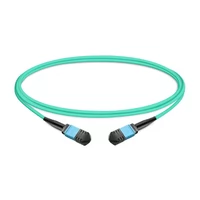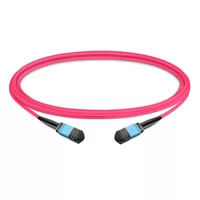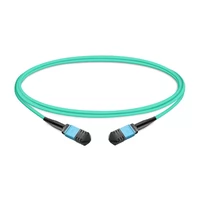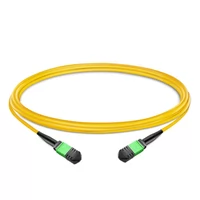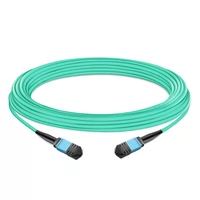In the fast-changing technological world, there is an increasing need for rapid data transmission speed, making good connectivity solutions important for businesses and telecommunication infrastructure. One significant breakthrough in this area is Multi-Fiber Push-On (MPO) cables that greatly help optimize fiber optic network performance. This article describes different types of MPO cables and their applications based on fiber optic connectors’ intricacies. Several configurations and standards are explained, thus giving the reader an idea of choosing suitable MPO connectors that can improve network efficiency and reliability. Whether you’re a beginner who wants to know more about fiber optics or an expert in the industry, this manual will be helpful for you because it covers the basics and the latest developments in MPO technology.
Table of Contents
ToggleWhat is an MPO Cable?

Understanding MPO Technology
MPO, or Multi-Fiber Push-On, is a structured cabling system for high-density fiber optic applications. An MPO connector can accommodate multiple fibers, usually 12, 24, or 48, in one unit, which makes it easier to manage large fiber counts. This type of standardized connector uses a flat ribbon cable that allows parallel optical connections, thus significantly increasing data transmission capacity while saving space in network environments. Particularly important for data centers and telecommunication hubs with limited space and bandwidth, MPO technology also provides push-on convenience so that quick connections can be made even under heavy demand installations, cutting down setup time and effort on maintenance works afterward. Knowing about MPO technology is essential in making decisions about deploying fiber optics and optimizing network performance.
Difference Between MPO and MTP
The MPO (Multi-Fiber Push-On) and MTP (Multi-Fiber Termination Push-On) connectors are often used interchangeably but have many technical differences. They are both standardized connectors for high-density fiber optic applications; however, the MTP is an upgraded version of the MPO with better performance and reliability. For example, what sets MTP connectors apart is that they have precision alignment pins, which enhance connection quality as well as durability by reducing signal loss risks, among others. Similarly, these types of connectors usually come with more stringent tolerances during production, thereby resulting in improved overall performance in high-bandwidth applications. Network designers or engineers need to know these variations so that they can choose the right type of connector based on their deployment requirements while still achieving optimal data transmission efficiency.
Common Uses of MPO Cables in Data Centers
Data centers use MPO cables for various applications because they are densely packed and transmit data well. For instance, one can find them in backbone cabling where MPO connectors enable many fiber strands to be combined into one cable management solution, thereby maximizing space utilization. Besides this, high-speed switches and routers also utilize these cables to facilitate quick data routing between interconnected devices. In optical distribution frames (ODFs), MPO cables play a crucial role in efficient management and establishing connections between incoming and outgoing fiber optic cables. Last but not least important is their increased usage within parallel optics applications such as 40G & 100G Ethernet, which supports higher bandwidth demand in today’s data centers.
How to Choose the Right MPO Cable?

Factors to Consider in Cable Selection
To guarantee that a network deployment is successful, there are many important things to consider when choosing an MPO cable:
- Core count: The number of fiber cores in an MPO cable determines a network’s bandwidth capacity. For instance, 12-core MPO cables can handle various data channels simultaneously, making them suitable for high-density applications. Therefore, evaluating current and foreseeable future network bandwidth needs is necessary to determine the appropriate core count.
- Type of Fiber: An MPO cable can have single-mode or multimode fibers installed on it. Single-mode fibers are intended for long-distance transmissions with low loss, which makes them ideal for campus networks, while multimode fibers offer higher bandwidths over shorter distances. Determining the purpose of use and transmission range will help select fiber types.
- Connector Configuration: Different connector configurations exist, such as MTP/MPO-8, MPO-12, or even MPO-24, each with different supported fibers. One should ensure that the cable connector configuration matches equipment compatibility requirements lest connectivity problems arise.
- Performance Standards: To rate a cable’s functionality, one must know its performance standards. These include Insertion Loss, Return Loss, and Total Attenuation. Cables with higher performance grades will have lower signal losses, essential for maintaining high data transmission rates. Industry associations like IEC 61754-7 can set these benchmarks.
- Environmental Factors: Depending on where cables will be installed, choosing appropriate sheathing and protective features is essential. For instance, outdoor-rated wires should meet specific ecological and durability criteria, such as moisture protection or UV resistance.
- Length and Routing: Length should be chosen based on the distance between various points within a data center and how these points are connected, either through direct connection or intermediate distribution areas (IDFs). This reduces clutter and prevents possible signal degradation.
By considering all these factors during the decision-making process, designers and engineers can ensure that they select the MPO Cable that best suits their needs, thereby guaranteeing performance and scalability in the network system.
Understanding Fiber Counts and Types
Knowing the various fiber counts and types available is crucial when choosing MPO (Multi-Fiber Push On) cables. Typically, fiber counts range from 8 to 144 fibers, with MPO-12 and MPO-24 being the most common configurations. Each configuration caters to different applications depending on data transmission requirements and network architecture.
Single-mode and multimode fibers are the main fiber types used in MPO cabling. Single-mode fibers are used in long-distance communication since they allow light to travel straight through the core, resulting in lower attenuation and higher bandwidth capabilities. Conversely, multimode fibers, which support multiple light paths, are ideal for shorter distances, hence their everyday use in data centers and enterprise networks.
Selecting appropriate fiber type(s) and count(s) can achieve optimal network infrastructure performance and future scalability. Sophisticated network designs may incorporate different fiber configurations to meet the specific needs of high-bandwidth applications and data-intensive environments. Network engineers who want to improve connectivity and efficiency in transferring data should know these fiber characteristics.
Cable Management and Installation Tips
There is nothing as important as effective wire management for the sake of system performance sustainability and tidy installation. This is some expert advice on how to use cable connectors effectively based on what is currently being practiced:
- Plan and Design: Plan out the layout of your cables so that they will not interfere with each other and can be accessed whenever you need to upgrade them in the future. You should also make sure that you keep everything organized by using cable trays or raceways, which reduce clutter.
- Labeling: All cables should be labeled properly at both ends using labels that will last long and are easy to read. This makes it easier for one person or another team member who might have come across this network before troubleshooting any problem, hence saving time while bringing down these networks during maintenance periods.
- Cable Grommets and Supports: Always use grommets and supports for cables where necessary to avoid sharp edges wearing through or weight-crushing them over time. It’s also important that we lift our wires up off surfaces rightly because this helps prevent their bending, which can sometimes block signals if done carelessly, thus greatly affecting performance.
- Don’t Bend Too Much: Do not bend any cable beyond its recommended minimum bend radius indicated by the manufacturer since doing so may cause signal loss within it. This is especially true for fiber optics, which are very sensitive to physical damages like breaks resulting from tight bends.
- Testing and Documentation: After installing everything, conduct tests thoroughly until all your wires pass per the prescribed performance standards. Then, write down every installation detail, such as types, counts, and topology, among others, so you may refer back later during scale-ups or other similar projects.
These measures will increase reliability and extend the lifespan of MPOs designed by network architects while still fostering an efficient flow of data during expansion phases across different networks.
Why Choose MPO Cables for High-Density Networks?
MPO cables (Multi-Fiber Push-On cables) are designed to support multiple optical fibers within a single connector, typically accommodating 8, 12, 24, or even 48 fibers. This makes them ideal for environments where space is limited and high bandwidth is critical, such as data centers and cloud computing facilities. Unlike traditional single-fiber connectors like LC or SC, MPO cables streamline cabling by consolidating multiple fibers into one compact unit, reducing installation time and improving cable management.
The key benefits of using MPO cables include:
- High Bandwidth Capacity: MPO cables support high-speed applications like 40G, 100G, and even 400G Ethernet, making them future-proof for growing network demands.
- Space Efficiency: By integrating multiple fibers into a single connector, MPO cables reduce cabling clutter, optimizing rack space and improving airflow in data centers.
- Ease of Installation: The push-on design of MPO cables allows for quick and secure connections, minimizing setup time and labor costs.
- Scalability: MPO cables support modular designs, enabling easy upgrades as network requirements evolve.
These advantages make MPO cables a preferred choice for businesses seeking cost-effective, high-performance optical communication solutions.
Best Practices for Implementing MPO Cables
To maximize the performance of MPO cables in your network, follow these best practices:
- Test and Certify Connections: Use an MPO tester to verify insertion loss, return loss, and polarity. This ensures optimal signal integrity and compliance with industry standards like TIA-604-5 and IEC 61754-7.
- Clean Connectors Regularly: Dust and debris can degrade MPO cable performance. Use specialized cleaning tools to maintain connector end faces, reducing signal loss and ensuring reliable connections.
- Plan for Scalability: Opt for MPO cables with higher fiber counts than currently needed to accommodate future upgrades, minimizing the need for costly re-cabling.
- Use Breakout Cables When Needed: For connecting MPO cables to equipment with LC or SC interfaces, use MPO-to-LC breakout cables to simplify transitions and maintain high-density benefits.
What are the Different Types of MPO Cables?

Trunk Cables vs. Breakout Cables
In multi-fiber optic networks, trunk cables and breakout cables, which are used for different purposes, are essential.
The trunk cable is designed to cover long distances while carrying multiple optical fibers. This makes it perfect for backbone interconnections within data centers or between buildings. Compared to other cables, trunk cables have a higher fiber count—usually ranging from 12 up to 144 or more. Because of this, they allow for faster data transfer with less signal loss thanks to a more robust design, which saves space, especially when installing lots of fan-out cords or these types of wire.
Breakout Cables work differently because each one has individual units that contain only single strands, so if necessary, you can separate these strands from the rest (hence called breakout). This feature enables direct connections between equipment thus making installation easier since it doesn’t require replacing an entire trunk every time there is an upgrade or during maintenance. Usually having lower fiber counts, such as twelve fibers, breakout wires are most appropriate for distribution points where many devices need patching through patch panels.
To sum up, trunk cables provide the main link for high-capacity connections, while breakout cords improve flexibility and ease network configurations. Based on this knowledge, maintenance procedures should be made during fiber optics installations.
Female and Male Connectors
Connectors are critical in fiber optic networks because they ensure data is transmitted effectively and reliably. Male connectors typically have a sticking-out alignment sleeve, which enables them to fit into female connectors designed with recessed structures for receiving these plugs. LC, SC, ST, and MTP or MPO are some of the most typical types of connector; each is appropriate for different applications, considering factors such as space availability, speed requirements, and ease of usage.
Female connectors, on their part, accept male connectors and are usually fixed on patch panels or wall outlets, providing an interface between optical fibers and network equipment. It should be noted that whether one chooses to use a male or female connector may affect various aspects of performance within the whole fiber optic system, including insertion loss and return loss. Therefore, proper selection of connectors becomes crucial for optimizing network efficiency and ensuring seamless connectivity throughout the system.
Types of MPO Fiber Links
MPO (Multi-Fiber Push-On) fiber connectors play a crucial role in high-density fiber optic systems because they allow for the quick connection and disconnection of multiple fibers. There are two types of MPO fiber links: Single-Mode MPO Links and Multi-Mode MPO Links.
- Single-mode MPO Links: These use single-mode fibers with small core diameters designed for long-distance communication. They are mostly used where high bandwidths need to be transmitted over large distances, like data centers or telecommunication networks.
- Multi-mode MPO Links: On the other hand, multi-mode MPO links employ larger core diameter fibers than single modes, which allows for the support of many light modes, thus making them suitable for short-distance transmissions. They act as bridges between different components within close proximity, such as those found in LANs (local area networks) or buildings.
Both types can take various forms depending on how many fibers they contain, ranging from 12-fiber to 24-fiber configurations, among others, to suit specific application demands. It is, therefore, important to select the correct one for an installation since this will greatly affect its performance and reliability when integrated into any network setup.
What are the Benefits of MPO Fiber Optic Cables?

High-Density Fiber Connectivity
In situations where space is at a premium, high-density fiber connectivity has many benefits. It enables space to be used efficiently by reducing the footprint of cabling infrastructure through MPO and other high-density connectors that consolidate numerous fibers into one interface. This is especially important in data centers and telecom hubs that require high bandwidths or fast cables/fanout cable deployments. Additionally, it supports scalability so networks can easily be upgraded or expanded without having to rewire everything; it also helps with cooling by letting more air flow around network equipment, which needs to operate under specific conditions. In conclusion, high-density fiber connectivity maximizes performance while keeping structured cabling environments at a minimum for improvement purposes for physical and logistic constraints.
Scalability and Flexibility
Scale and flexibility are two key features of MPO fiber optic cabling systems that can support dynamic and growing network architectures. These systems enable expansion by integrating more fibers into the system without a need for major infrastructure changes. Organizations can adjust their network capacities easily as demand for data increases by using additional MPO connectors and adaptors with different fiber counts or arrangements, such as those having 12-fiber cables at a lower cost. In addition, the modular nature of these systems allows quick alterations in network layouts so that new technologies and equipment may be incorporated rapidly where needed. Such flexibility is essential for businesses experiencing fluctuating workloads or requiring fast scaling of their activities due to market variations. Thus, an organization gets a strong future-ready networking solution that will remain highly performing and reliable throughout its growth.
Reduction of Cable Clutter
High-density MPO fiber optic cabling systems have the advantage of reducing cable clutter. They do this by merging many fibers into one connector, so fewer individual cables must deal with it, making for a tidier network environment. Not only does this method make the workspace look more appealing, but it also ensures that maintenance and troubleshooting can be easily accessed. In addition, organizations can lower the risk of tangling or damaging the physicality of the fibers because there will be fewer amounts used. Space can still be optimized with sound vertical/horizontal management systems so cables remain easily navigable and manageable. Ultimately, high-density solutions bring efficiency in managing cables, which in turn enhances reliability and performance across networks at large.
How to Maintain and Test MPO Cables?

Cleaning and Inspection Techniques
Proper cleaning and inspection techniques are needed to maintain the integrity and performance of MPO fiber optic cables. That means using special tools designed for fiber optics, like lint-free wipes and isopropyl alcohol, to clean these connectors well without contaminating them. A regular check with a portable fiber microscope may detect scratches or dirt that could affect signal quality. Having a maintenance schedule and training staff on how to handle and clean it properly will keep your cabling system always in its best state. Otherwise, you can also employ automated testing equipment that validates performance parameters more comprehensively, thus ensuring that network infrastructure operates efficiently and reliably.
Testing MPO Connector Performance
Several testing methods can be used to evaluate the effectiveness of MPO connectors. An Optical Time Domain Reflectometer (OTDR) is the most commonly used method. This tool allows technicians to send light pulses through the connector and measure the loss and bandwidth of the fiber link. Another system test known as insertion loss helps quantify how much amount light is lost when passing through an MPO connection; it also measures overall efficiency in the system. For compatibility and reliability assurance, adherence to such industry standards as IEC 61300-3-34 should be ensured with these components. Regular performance tests are essential because they help identify lower-quality connections that may lead to slower network speeds or dropped packets; this allows for early detection before any effect on network performance occurs. Automated testing systems can make this process easier by providing quick and accurate results without human error.
Common Problems and Troubleshooting Tips
Network performance can be affected by several common problems in MPO connectors. One such issue is connector contamination, which can cause large amounts of insertion loss. You should inspect your connectors regularly and clean them appropriately, for example, with lint-free wipes and specific solvent solutions.
Another typical problem occurs when connectors are not aligned correctly; this can result in signal degradation. Always ensure that the connector is properly seated and aligned during installation; if necessary, use tools like an optical power meter to diagnose alignment issues accurately.
In addition, physical damage to cables or connectors may lead to connectivity problems, too. Use a portable fiber microscope for regular inspections – it will help you detect any scratches, cracks, or signs of wear requiring repair or replacement. Environmental conditions such as temperature changes also impact MPO connection performances; therefore, one should implement good cable management practices and thermal insulation methods to minimize those risks. These are why it’s important to test performance periodically, follow installation best practices, and provide comprehensive staff training to avoid common problems while ensuring a strong, reliable fiber optic network.
Reference Sources
Frequently Asked Questions (FAQs)
Q: What do MPO cables mean?
A: A multi-fiber Push-on (MPO) cable is an optical fiber cable that can support multiple fibers and connectors on one end. Because of its high efficiency and performance, it is widely used in high-density cabling networks.
Q: What are the different types of MPO trunk cables?
A: MPO trunk cables come in many configurations, such as 12-fiber cables, 16-fiber parallel fiber links, and 24-fiber cables. These cables have connectors at both ends, making them perfect for systems with dense cabling.
Q: What is the difference between Type A, B, and C MPO cables?
A: The three main types of MPO cables are type A, which is straight-through or non-pinned; type B, which is reversed or flipped polarity cable; and type C, also known as crossover or split pairs polarity cable. Each supports different cabling applications and positions within the connector suitable for system design communication and multipurpose cable setup.
Q: Why are MPO trunk cables suitable for high-density cabling networks?
A: An MTP/MPO trunk cable can house multiple optical fibers, significantly reducing overall space requirements compared to using individual patch cords. This makes it ideal for high-density cabling networks.
Q: What is an MPO female connector?
A: An MTP/MPO female connector has holes instead of pins. This connector mates with an MTP/MPO male connector and is often used in MTP/MPO trunking systems.
Q: How does one select the right MPO cable type for their needs?
A: To determine which MPO cable type will work best, consider the number of fibers needed, the type of connectors used, the fiber mode, and the specific application requirements. A selection guide might help you make an informed decision.
Q: What is a fiber patch panel?
A: A fiber patch panel is designed to manage and organize optical connections. Fiber cables are terminated and connected here, making it easy to manage the ends of a fiber link in a network.
Q: What is the function of conversion cables in MPO systems?
A: Conversion cables connect different types or modes of fiber optic connectors, ensuring compatibility within an optical fiber cabling system.
Q: Can MPO cables be utilized with both single-mode and multimode fibers?
A: Yes, they can. The choice between single-mode and multimode depends on distance requirements and bandwidth, among other things the network needs.
Q: What is typically an MPO trunk cable used for?
A: In data centers or other high-density network environments where many connections need to be made quickly from one place, such as switches, transceivers, etc., these types of cables provide reliable methods for managing large numbers of connections across multiple types/cores of wires.
Related Products:
-
 1m (3ft) 12 Fibers Female to Female MPO Trunk Cable Polarity B LSZH OM3 50/125 Multimode Fiber
$20.00
1m (3ft) 12 Fibers Female to Female MPO Trunk Cable Polarity B LSZH OM3 50/125 Multimode Fiber
$20.00
-
 1m (3ft) 12 Fibers Female to Female MPO Trunk Cable Polarity B LSZH Multimode OM4 50/125
$21.00
1m (3ft) 12 Fibers Female to Female MPO Trunk Cable Polarity B LSZH Multimode OM4 50/125
$21.00
-
 1m (3ft) 12 Fibers Female to Female MPO Trunk Cable Polarity B LSZH OS2 9/125 Single Mode
$26.00
1m (3ft) 12 Fibers Female to Female MPO Trunk Cable Polarity B LSZH OS2 9/125 Single Mode
$26.00
-
 1m (3ft) 12 Fibers Low Insertion Loss Female to Female MPO Trunk Cable Polarity B LSZH OM3 50/125 Multimode Fiber
$32.00
1m (3ft) 12 Fibers Low Insertion Loss Female to Female MPO Trunk Cable Polarity B LSZH OM3 50/125 Multimode Fiber
$32.00
-
 1m (3ft) 12 Fibers Low Insertion Loss Female to Female MPO Trunk Cable Polarity B LSZH Multimode OM4 50/125
$33.00
1m (3ft) 12 Fibers Low Insertion Loss Female to Female MPO Trunk Cable Polarity B LSZH Multimode OM4 50/125
$33.00
-
 3m (10ft) 12 Fibers Low Insertion Loss Female to Female MPO Trunk Cable Polarity B APC to APC LSZH Multimode OM3 50/125
$35.00
3m (10ft) 12 Fibers Low Insertion Loss Female to Female MPO Trunk Cable Polarity B APC to APC LSZH Multimode OM3 50/125
$35.00
-
 1m (3ft) 12 Fibers Low Insertion Loss Female to Female MPO Trunk Cable Polarity B LSZH OS2 9/125 Single Mode
$40.00
1m (3ft) 12 Fibers Low Insertion Loss Female to Female MPO Trunk Cable Polarity B LSZH OS2 9/125 Single Mode
$40.00
-
 5m (16ft) 16 Fibers Female to Female MPO Trunk Cable Polarity B LSZH OM4 50/125 Multimode Fiber APC
$89.00
5m (16ft) 16 Fibers Female to Female MPO Trunk Cable Polarity B LSZH OM4 50/125 Multimode Fiber APC
$89.00

